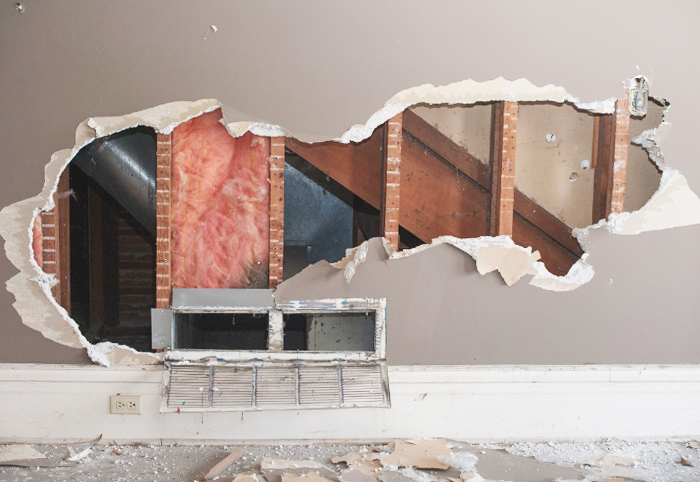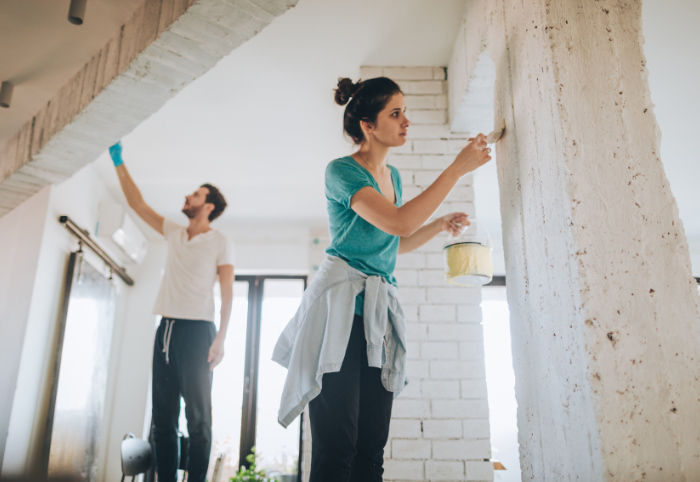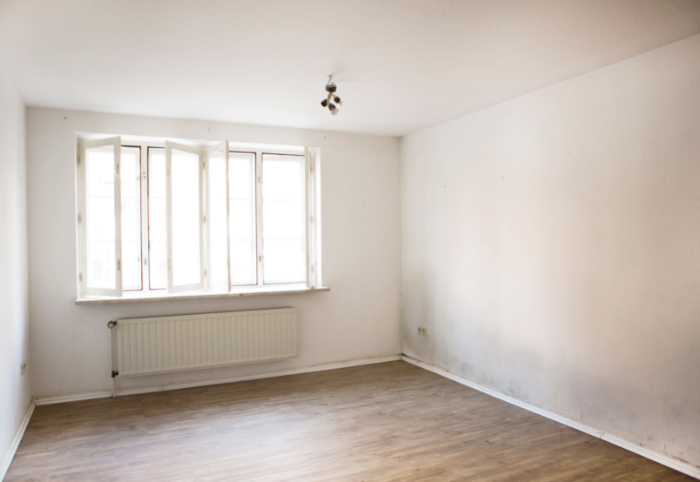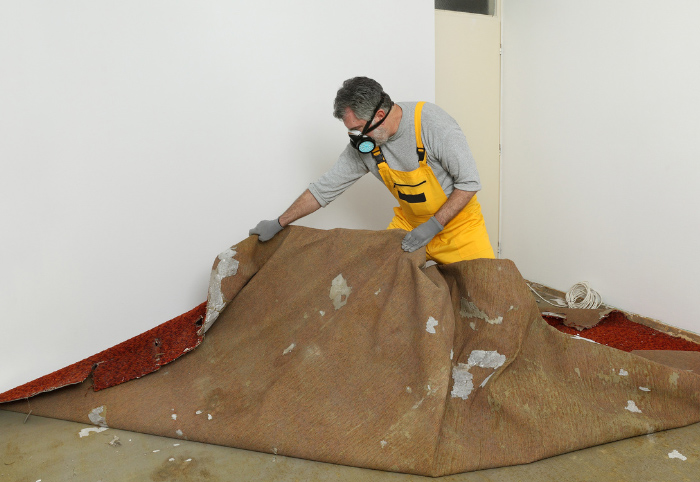Renovating5 Health Hazards to Avoid When Renovating

Renovating is exciting, especially after spending months or years planning your project. But there are some hidden health hazards you need to avoid when starting any type of home renovation.
Avoiding house renovation health risks is easy with some foresight and a little planning. Over the last decade, I discovered that many of my clients had become unwell due to their homes. And in most cases, the causes were avoidable.
To help prevent you and your loved ones from hidden risks that you could encounter when renovating, I’m going to take you through the five most common risks and give you some pointers on managing them safely.
5 House Renovation Health Hazards To Avoid
Read on for a clear explanation of the most common health hazards associated with home renovations.
Risk 1: Asbestos Alert

Asbestos exists in many materials. Always remember that 100% of asbestos-related illnesses (including mesothelioma) are preventable.
While it’s impossible to know if a material contains asbestos just by looking at it, I wanted to point out a few signs that asbestos could be present:
- Materials that look like they contain fibres on broken or exposed edges
- If the building was built or remodelled between 1950 -1970s (asbestos was banned in 2003, but these decades saw peak use)
- Beading along the joins of soffits and/or internal walls
- Yellow glass
- Old carpet or lino
Strong and less flammable than other options, asbestos was widely used in the past. Some of its uses include roof and wall tiles, plasterboards and sheeting, window sashes, slagging, old laundry tubs, cement pipes, carpet underlays, tiles, bakelite materials and more!
The only way to be certain of its presence is to send a sample for laboratory assessment. Have your house assessed by a licensed asbestos inspector and ask for a “Demolition Survey.”
Risk 2: Lingering Lead

Due to its numerous health risks, the use of lead-based materials was also phased out. Lead poisoning can result in many long-term health effects including lowered IQ, and reduced sperm count and has been linked to the diseases of ageing.
Like asbestos, lead is largely not problematic until it is disturbed. Lead can be present in paint, solder, leadlighting, petrol, cosmetics, tapware and more.
Spot tests available at hardware stores are unreliable, and for this reason, laboratory analysis is recommended. If you don’t want the expense of testing, assume that everything contains lead – and take extra care!
- Wear PPE (Personal Protective Equipment – such as respirator, gloves, coveralls)
- Avoid dry sanding and heat guns to remove paint
- Wet carpets, cut into stripes before rolling them up and removing them carefully
- Avoid secondary contamination by carefully managing dust
- Keep pets, pregnant women, children and the elderly away from rooms under renovation
A fantastic resource for more information is Lead Safe World.
Risk 3: Mitigate Mould

Where there is mould, there is a moisture problem. In fact, it is possible for any moist area of the home to have dormant mould spores – a common renovation health hazard.
Remember, mould is not always visible, and any colour mould is problematic for health – especially in someone who is allergic to it. This means that members of the household could all have different experiences with exposure moulds, some could react strongly and others not at all.
Be aware that any time that you disturb mould, it releases spores in its attempt to “survive the attack.” Disturbing mould could be changing the light, temperature, air movement; altering the amount of moisture that is present, or physically disturbing it.
I’ll never forget what happened years ago when my client took me into the cellar to show me the water damage. We climbed down into it and she turned the light on – then everything went black! What had happened was that we’d caused an inrush of air, changed the light and the temperature which caused the mould that was present to release spores. The air became thick with spores, and only once they settled could I see her again.
Look for areas affected by water: leaks, flooding, burst pipes and so on. Here are some clues for you:
- Look for “wood rot” (I call this “water damage”)
- A water line on the subfloor, stumps or on the walls
- Brown stains
- Peeling or bubbling paint
- Swollen wood
All of these indicate that moisture has been an issue at some point and could indicate the presence of mould.
Get professionals to remove water-damaged materials and mould. And if you have any suspicions about the presence of mould, wear a P3 respirator during investigations.
Risk 4: Dangerous Dust

Dust is often part and parcel of a renovation – due to demolition, cutting, sanding, and so forth. But did you know that dust can pose a hazard to health, and not just because it contains house dust mites?
Dust within the building envelope can be laden with toxins and contaminants, such as lead, asbestos, pesticides, herbicides, faeces, and more! Ceiling dust is one of the major concerns I have with renovation.
Fortunately, there’s an easy way to avoid the problem. Simply have the dust removed by a specialist. The Australian Dust Removal Association has accredited members who are aware of the hazards and can safely remove the dust for you. I recommend removing ceiling dust for any renovation that involves the ceiling – adding downlights, removing a portion of the ceiling, replacing insulation, and so on.
Risk 5: Crusty Carpets

Carpets, while adding comfort and warmth to our homes, are also “garbage dumps” for contaminants, especially when wearing shoes in the house. And when carpets are removed, you’re exposed to all that garbage.
Carpets also soak up mould spores and other particulates from the air. These contaminants lodge deep within the pile and are difficult to remove.
Tips to protect your health when removing carpets:
- Wear PPE (Personal Protective Equipment – such as respirator, gloves, coveralls)
- If you are removing carpet from one part of your home, then seal off the room to prevent any dust from spreading into other rooms
- Cut the carpet into strips, spray it with water as you roll it up and carry it outside immediately
- Due to carpets’ ability to collect “garbage,” I recommend not having them. To provide warmth,
comfort and colour, rugs can be a great alternative.
From your complete bathroom reno to simply rearranging a room, it’s very easy to get caught up in the vision, the decision-making and the project management. But keep these home renovation health hazards in mind and protect your health now and into the future. I’ll be back soon to share more tips with you about healthy renos.

Lucinda Curran is a Healthy Home Specialist with a background in building biology, health sciences and education. She has a thorough understanding of the ways in which buildings can adversely affect overall health and vitality. Lucinda has been an active committee member for ASBB, IAQA (Australian Chapter) and The LEAD Group.